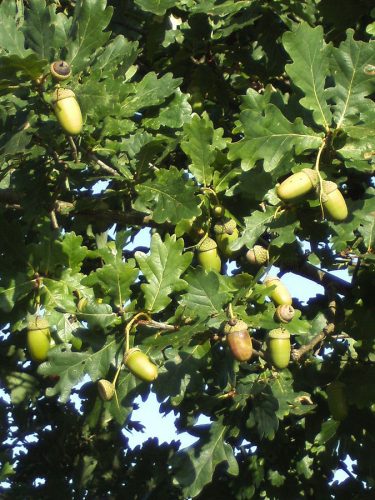Oak, deciduous tree growing up to 20–40m tall.
Also known as:
English oak
Pedunculate oak
Common oak
Not to be confused with:
Sessile oak (Quercus petraea)
You are viewing the mobile-adapted version of the page.
The one for tablets, laptop and desktop also provides general information, such as origin, toxicity and cultivation.
Oak (Quercus) is a deciduous tree. The best known is the English or common oak (Quercus robur). The Sessile oak (Quercus petraea) is less common.
The length of the leaf stalk (short: 2 to 8 mm – English oak, long 10 to 30 mm – sessile oak) is the most obvious difference between the two oaks. The leaves of the sessile oak are darker and firmer than those of the English oak. The withered leaves of the sessile oak remain largely on the tree in winter; the English oak loses all its leaves in winter.
Oaks are hefty trees: a freestanding oak can grow as tall as 40 m; in forests, they do not grow taller than 30 m. Oaks can get very old: there are oaks over a thousand years old.
Sessile oaks are slightly less susceptible to fungus, caterpillars and bugs. English oaks can withstand a high groundwater level better; the Sessile oak doesn’t like wet feet.
Other species of oak:
– Holm oak (Quercus ilex)
– Turkey Oak (Quercus cerris)
– Cork oak (Quercus suber)
– Northern red oak (Quercus rubra)
Bugs
Yellow spots on the leaves: aphids.
Feeding damage of the budding buds and young leaves: caterpillars (knows as inchworms) of the winter moth (Operophtera brumata).

Large, yellow to red gall cones on the underside of the leaf; the gall consists of proliferating mesophyll: Cherry Gall Wasp (Cynips quercusfolii).
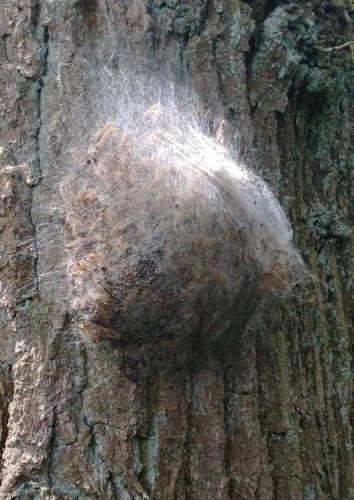
Large numbers of caterpillars in webs on the sunny side of the trunk (usually oak); leaves are eaten bare: caterpillars of the Oak processionary caterpillar (Thaumetopoea processionea).
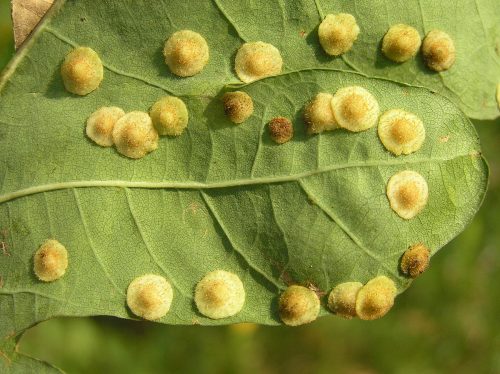
Yellow spots on the top of the leaves and small, flat-rounded galls (globules) on the underside, discoloring from pale yellow to red: Common spangle gall (Neuroterus quercusbaccarum).
Growth of the tree stops, tree dries out and eventually dies: under the bark are tunnels interrupting the sap flow: the larvae of the Oak jewel beetle (Agrilus biguttatus).
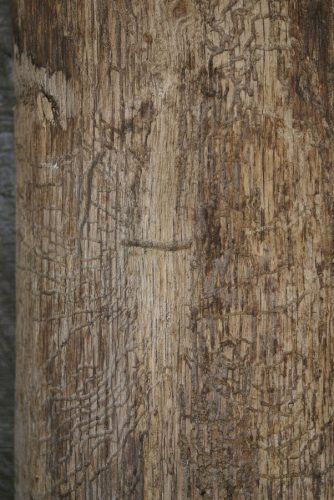
A pattern of tunnels between the bark and the bark, fine sawdust can be seen. The tree weakens, dries out and dies: Oak Bark Beetle (Scolytus intricatus).
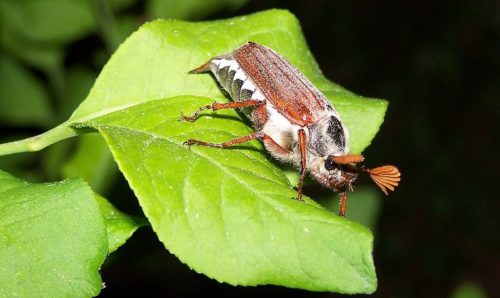
Leaf is eaten by 3 cm brown beetles: Common Cockchafer (Melolontha melolontha). A swarm of Common cockchafers can eat an oak tree completely bare.
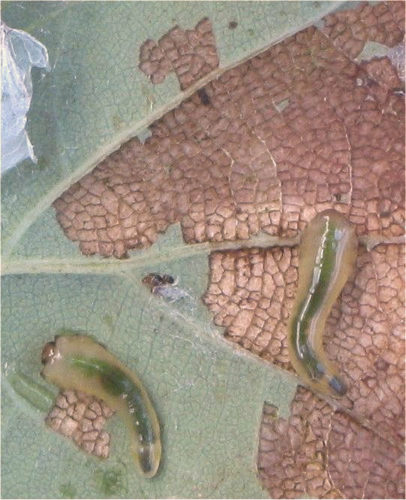
About 1 cm small, dark-tinged, slimy snails eat the mesophyll between the veins of the leaves. This causes the remaining mesophyll to turn brown and the leaves may drop: slug-like caterpillars lookalikes: larvae of the Oak Slug Sawfly (Caliroa annulipes).
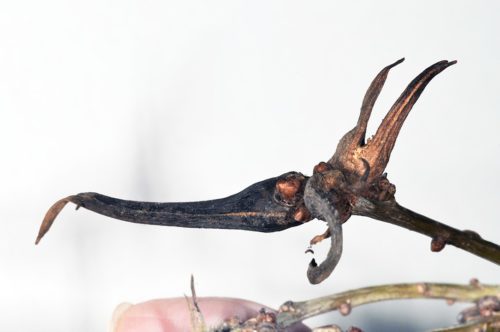
Particularly shaped gall: elongated with long appendages: gall of the Ram’s horn Gall Wasp (Andricus aries). In spring and summer, the galls are light green; after the gall wasp fledges, the gall turns brown.
Fungi & diseases
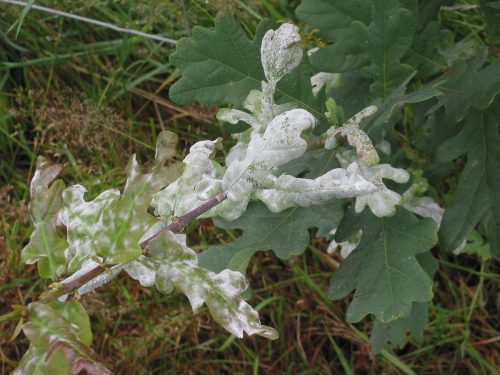
White, frouly patches (young trees): Powdery mildew (Mycrosphaera alphitoides – a species of the sac fungi or Ascomycetes).
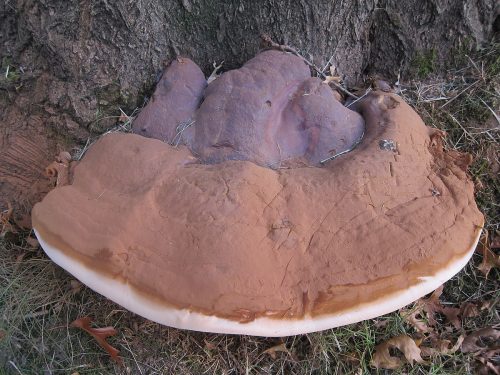
Mushroom formation on trunk: fan-shaped fungus, shiny orange/brown top. The spores are found as cocoa-like powder around the fungus. The fungus can grow half a meter wide on old, large trees: Lacquered bracket (Ganoderma resinaceum).
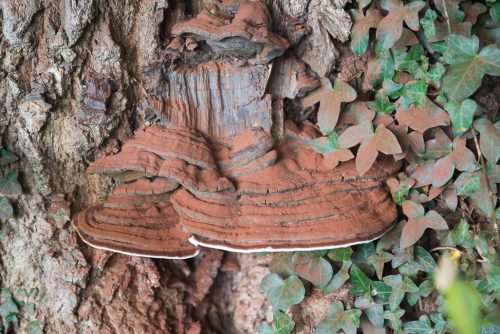
Fruiting bodies in the shape of a horseshoe on the trunk. The fungus is cinnamon-colored, slightly convex at the top, flat at the bottom and has a white ran
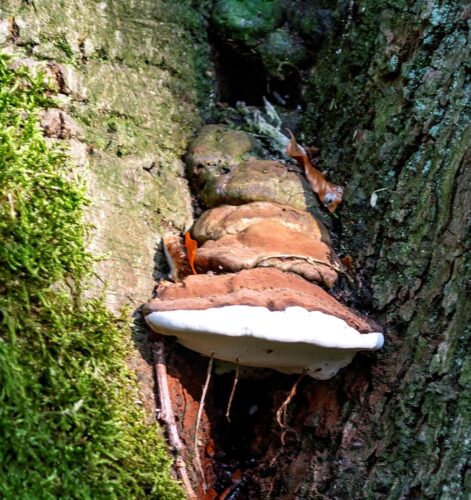
The light brown fungi have a white edge and the underside with the pore layer is pale white. Sometimes the fungi grow tile-like on top of each other. The top of the fungus and the surrounding area are often dusted with reddish-brown spores: Southern bracket (Ganoderma australe).
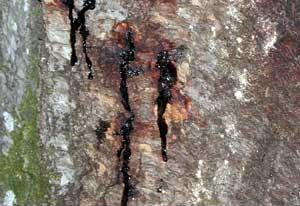
Moisture spots develop on the tree – tree bleeds. Under the bark, the trunk is brown and the oak becomes bare in no time (extreme leaf loss) and dies: SOD (Sudden Oak Death) – Phytophthora ramorum.
Other
Frost cracks in the trunk (young trees) can occur after a late night frost.
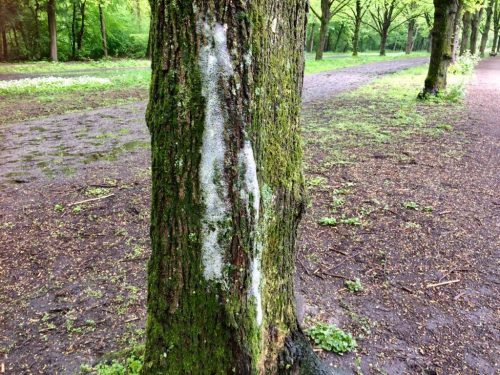
In early spring, foam appears at the base of the trunk: tree foam.

